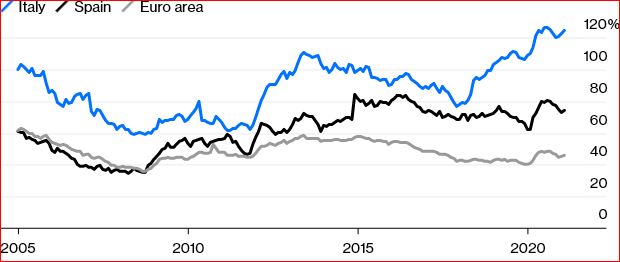Completing the EU’s banking union might be the only way to avoid the dreaded “doom loop.”
Europe faces a predicament. Even as it struggles to contain the
Covid-19 pandemic, it’s setting itself up for another crisis — this one
financial. To ensure the viability of the common currency at the heart
of the European project, the EU’s leaders will have to cooperate in ways
they’ve so far resisted.
Adopting the single currency has yielded great benefits, from
frictionless trade to improved global competitiveness. But the euro
also obliged member states to relinquish the independent monetary
policies that can help backstop national debts and financial systems.
One result is that distress at banks presents a heightened threat to
individual governments’ finances, and vice versa — the so-called “doom
loop” that played out in spectacular fashion during the early 2010s,
when the euro area nearly broke apart.
In 2012, European leaders agreed
on what should have been a big part of the solution. They envisaged a
full banking union, in which governments would take joint responsibility
for supervising financial institutions — and, most important, for
dismantling or recapitalizing banks when necessary, and for making
depositors whole. Progress has been excruciatingly slow. Although the
European Central Bank now oversees the region’s largest banks,
individual governments still bear the cost of rescues, as bailouts in Italy and Germany have demonstrated. Mutual deposit insurance remains no more than a proposal.
The pandemic has aggravated the problem, with governments
taking on ever more debt in their efforts to provide economic relief.
The International Monetary Fund estimates
that general government debt in the euro area will exceed 98% of gross
domestic product by the end of 2021, up from 84% at the end of 2019.
Worse, individual countries’ obligations are accumulating
on the balance sheets of their banks. At the end of February, Italian
banks’ holdings of Italian government debt amounted to 124% of their
capital and loss reserves, rendering them extremely vulnerable in the
event of fiscal distress.
Too Close to Home
Banks' holdings of home government debt have surged amid the pandemic*

Source: European Central Bank
Aside from the financial risks they present, these sovereign
exposures make banking union harder to achieve politically. Northern
countries such as Germany, for example, don’t want to sign on to mutual
deposit insurance if it means subsidizing Italian banks’ excessive
holdings of Italian public debt. Governments of heavily indebted
countries, for their part, worry that restrictions on banks’ holdings
could render them unable to borrow when they have to.
There’s a way forward. To nudge banks toward diversification,
the ECB could designate a “safe portfolio” of government debt,
corresponding to member states’ shares of the region’s GDP (an idea
originally proposed by German Finance Minister Olaf Scholz, and elaborated
by Luis Garicano, an economist and member of the European Parliament).
Any divergence would entail an increase in capital requirements. This
would address northern countries’ concerns by giving banks an incentive
to reduce home-government exposures. At the same time, it would moderate
the pressure that would otherwise be imposed on heavily indebted
governments: The decrease in Italian banks’ holdings of their
government’s debt would be at least partially offset by increases in
other banks’ holdings....
more at Bloomberg
© Bloomberg
Key

Hover over the blue highlighted
text to view the acronym meaning

Hover
over these icons for more information

Comments:
No Comments for this Article